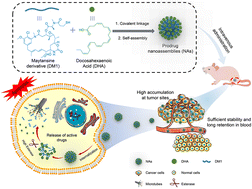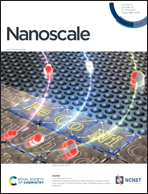Transforming a highly toxic agent DM1 into injectable safe nanomedicines via prodrug self-assembly for the treatment of taxane-resistant cancer†
Abstract
Drug resistance is one of the major obstacles for successful chemotherapy of malignant tumors including cervical cancer. To overcome this problem, a lot of efforts have been made, and drug nanoformulation may be a possible solution. Maytansine and its derivatives, the powerful tubulin polymerization inhibitors, have superior anti-tumor activity toward multiple malignant tumors compared with most anti-tumor drugs including doxorubicin, camptothecin, and cabazitaxel in current clinical studies. Nevertheless, they are hard to be accepted as clinical drugs due to their systemic toxicity to the human body, no tumor targeting, and insolubility in aqueous solutions. In this work, a strategy, called PUFAylation, has been developed to modify maytansinoid (DM1) with a polyunsaturated fatty acid (PUFA) to solve these problems by covalently coupling DM1 and docosahexaenoic acid (DHA). Two types of PUFAylated prodrugs (i.e., dSS-DM1 and dMT-DM1), prepared through different linking strategies via a thiol-disulfide exchange reaction and maleimide–thiol reaction, respectively, can self-assemble in aqueous solution to form nanoassemblies (NAs) for preclinical study by intravenous injection. In a BALB/c nude mouse model bearing cell-derived xenografts, there was no significant weight loss in mouse groups treated with dSS-DM1 NAs and dMT-DM1 NAs. In contrast, the mice with intravenous injection of free DM1 suffered a significant weight loss during the treatment. At the same time, dMT-DM1 NAs exhibit similar anti-tumor effects to free DM1 (p > 0.05). Overall, by modification of the chemotherapeutic drugs, the systemic toxicity and side effects of DM1 can be effectively reduced without sacrificing its anti-tumor effect. Particularly, dMT-DM1 NAs had shown superior therapeutic effects against drug-resistant cervical cancer and may be a potential alternative for clinical treatment of cervical cancer with paclitaxel resistance. Furthermore, this DM1-formulated platform may be applied to other anticancer agents due to its simplicity.



 Please wait while we load your content...
Please wait while we load your content...